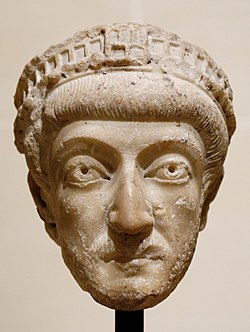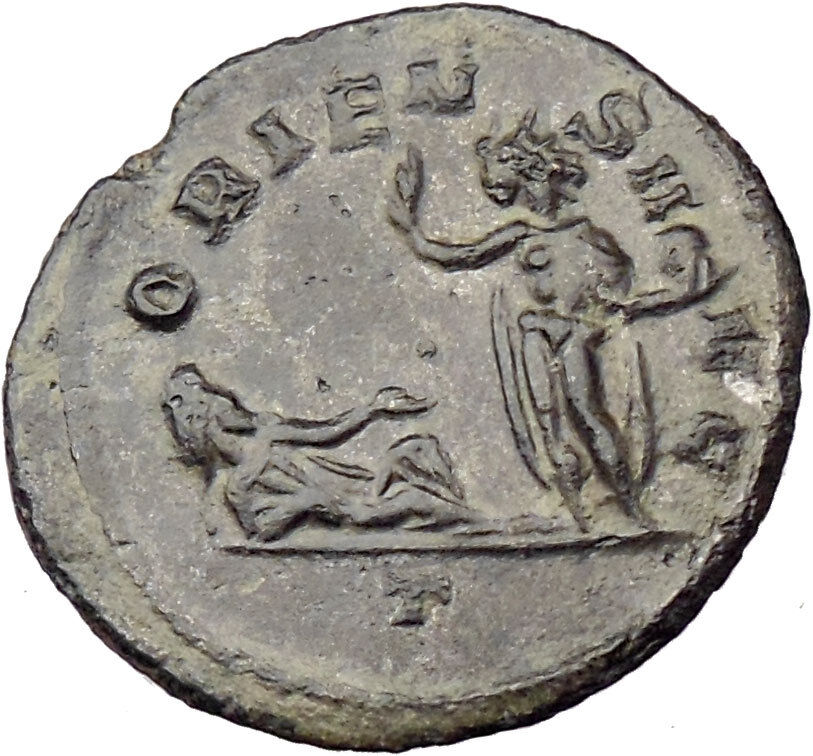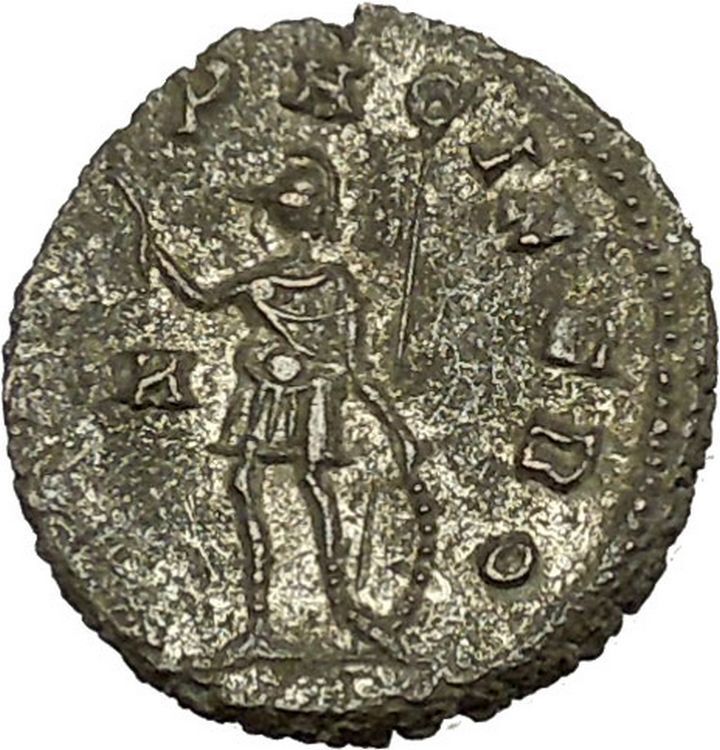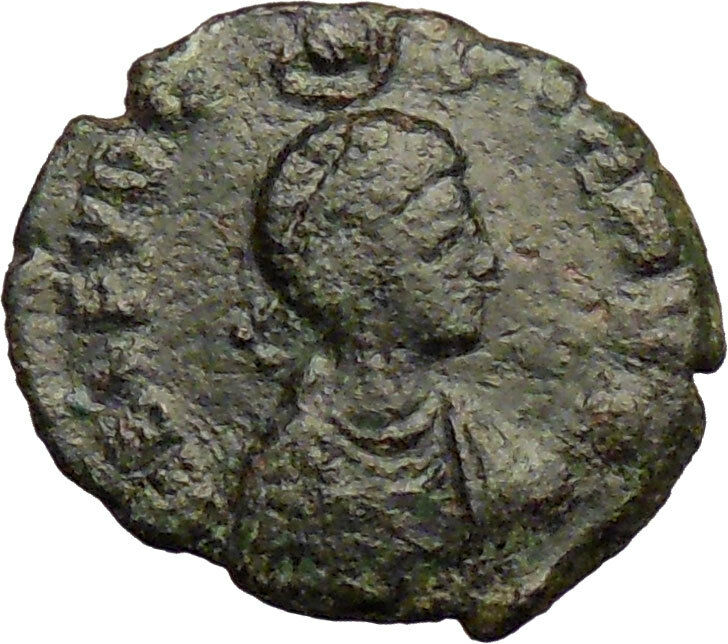|
Theodosius II – Roman Emperor: 408-450 A.D. –
Bronze AE4 14mm (1.68 grams) Alexandria mint circa 406-408 A.D.
Reference: Possibly Unpublished
DN THEODOSIVS PF AVG, pearl diademed, draped & cuirassed bust right, star
behind head
GLORIA ROMANORVM, the three emperors Arcadius, Honorius and Theodosius
standing facing, all holding spears, the two outermost also resting hand on
shields. ALE in ex.
You are bidding on the exact item pictured,
provided with a Certificate of Authenticity and Lifetime Guarantee of
Authenticity.
 Theodosius Theodosius
II (10
April 401
–
July 28
,
450), called
the
Calligrapher
, was a
Eastern Roman Emperor
(408-450). He is mostly known for promulgating the
Theodosian law code
as well for the
Theodosian Walls of Constantinople
. He also presided over the outbreak of
two great christological controversies
.
Setting a record for longest-reigning Roman emperor
at 48 years (equivalent to a dozen U.S. Presidential terms!), Theodosius
II set remarkably few other records in all this time. He was the last
emperor to rule both east and west halves, albeit briefly, after the
death of Honorius and before the puppet emperor Johannes came onto the
scene. As for his own achievements, he wasn’t much more than a
figurehead esconced in his palace. His sister Pulcheria took the active
role in steering the empire. He died a few days after a hunting
accident.
Life
Theodosius was born in 401 as the only son of Emperor
Arcadius
and his Frankish-born wife
Aelia
Eudoxia
. In 408, his father died and the seven-year-old boy became Emperor
of the Eastern parts of the Roman Empire.
Government was at first by the
Praetorian Prefect
Anthemius
, under whose supervision that the
Theodosian land walls
of Constantinople were constructed.
In 414, Theodosius’ older sister
Pulcheria
was proclaimed Augusta and assumed the regency. By 416 Theodosius was capable of
ruling himself, but his sister remained a strong influence on him. She also
assisted her brother in procuring marriage to the Athenian
Aelia
Eudocia
in June 421. The two had a daughter named
Licinia Eudoxia
.
Theodosius’ increasing interest in Christianity, fuelled by
the influence of Pulcheria, had him start a
war against the Sassanids
(421-422), who were persecuting Christians; the
war ended in a draw, when the Romans were forced to accept peace as the Huns
menaced
Constantinople
.[1]
In 423, the Western Emperor
Honorius
, Theodosius’ uncle, died and the
primicerius notariorum
Joannes
was
proclaimed Emperor. Honorius’ sister
Galla Placidia
and her young son
Valentinian
fled to Constantinople to seek Eastern assistance and after some
deliberation in 424 Theodosius opened the war against Joannes. In May 425,
Valentinian III was installed as Emperor of the West, with his mother acting as
regent. To strengthen the ties between the two parts of the Empire, Theodosius’
daughter
Licinia Eudoxia
was betrothed to Valentinian.
University
and Law Code
In 425, Theodosius founded the
University of Constantinople
with 31 chairs (15 in Latin and 16 in Greek).
Among subjects were law, philosophy, medicine, arithmetic, geometry, astronomy,
music and rhetoric.
In 429, Theodosius appointed a commission to collect all of
the laws since the reign of
Constantine I
, and create a fully formalized system of law. This plan was
left unfinished, but the work of a second commission that met in Constantinople,
assigned to collect all of the general legislations and bring them up to date
was completed, and their collection published as the
Codex Theodosianus
in 438. The law code of Theodosius II, summarizing
edicts promulgated since Constantine, formed a basis for the law code of Emperor
Justinian
I
in the following century.
Wars
with the Huns, Vandals and Persians
The Eastern Empire was also plagued by short raiding attacks
by the Huns
. The
Huns arrived at
Athyra (Büyükçekmece)
in 447, but an agreement was reached with the
Eastern Roman empire
, negotiated by
Anatolius
. The Emperor chose to pay tribute which amounted to 350 Roman
pounds (ca. 114.5 kg) of gold until 435 and 700 Roman pounds after that.
When Roman Africa fell to the Vandals in 439, both Eastern
and Western Emperors sent forces to
Sicily
, to
launch an attack at the Vandals at Carthage, but this project failed. Seeing the
imperial borders without significant forces, the
Huns and
Sassanid Persia
declared war. During 443 two Roman armies were defeated and
destroyed by the Huns. In the subsequent peace agreement Roman tribute was
tripled to 2,100 Roman pounds (ca. 687 kg) in gold after which the Huns withdrew
into the interior of their empire. The
war with Persia
on the other hand proved indecisive, and a peace was
arranged in 422 without changes to the status quo.
Theological
disputes
During a visit to Syria, Theodosius met the preacher
Nestorius
and appointed him Patriarch of Constantinople in 428. Nestorius quickly became
involved in the disputes of two theological factions, which differed in their
Christology
. Nestorius tried to find a middle ground between those that,
emphasizing the fact that in Christ God had been born as a man, insisted on
calling
the Virgin Mary
Theotokos (“birth-giver of God”), and those that
rejected that title because God as an eternal being could not have been born.
Nestorius suggested the title Christotokos (“birth-giver to Christ”), but
did not find acceptance by either faction and was accused of detaching Christ’s
divine and human natures from each other, a heresy later called
Nestorianism
. Though initially supported by the Emperor, Nestorius found a
forceful opponent in Patriarch
Cyril of Alexandria
. With the consent of the Emperor and
Pope Celestine I
, an
Ecumenical Council convened in Ephesus
in 431, which affirmed the title
Theotokos and condemned Nestorius, who was then exiled by the Emperor.
Almost twenty years later, the theological dispute broke out
again, this time caused by the Constantinopolitan abbot
Eutyches
,
whose Christology was understood by some to mingle Christ’s divine and human
nature into one. Eutyches was condemned by Patriarch
Flavian of Constantinople
but found a powerful friend in Cyril’s successor
Dioscurus of Alexandria
.
Another council convoked to Ephesus
in 449, deemed “robber synod” because of
its tumultuous circumstances, restored Eutyches and deposed Flavian, who was
mistreated and died shortly afterwards.
Pope Leo I
of Rome and many other bishops protested against the outcome, but the Emperor
supported it. Only after his death in 450 would the decisions be reversed at the
Council of Chalcedon
.
Death
Theodosius died in 450 as the result of a riding accident. In
the ensuing power struggle, his sister
Pulcheria
,
who had recently returned to court, won out against the
eunuch
Chrysaphius
. She married the general
Marcian
,
thereby making him Emperor.
Flavius
Arcadius (377/378–1 May 408) was
Byzantine Emperor
in the Eastern half of the
Roman
Empire
from 395 until his death.
//
Arcadius was born in
Hispania
,
the elder son of
Theodosius I
and
Aelia Flaccilla
, and brother of
Honorius
, who would become a
Western Roman Emperor
. His father declared him an
Augustus
and co-ruler for the
Eastern half of the Empire
in January, 383. His younger brother was also
declared Augustus in 393, for the Western half.
As emperors, Honorius was under the control of the Romanized
Vandal
magister militum
Flavius
Stilicho
while Arcadius was dominated by one of his ministers,
Rufinus
. Stilicho is alleged by some to have wanted control of both
emperors, and is supposed to have had Rufinus assassinated by Gothic mercenaries
in 395; though definite proof of Stilicho’s involvement in the assassination is
lacking, the intense competition and political jealousies engendered by the two
figures compose the main thread of the first part of Arcadius’ reign. Arcadius’
new advisor, the eunuch
Eutropius
, simply took Rufinus’ place as the power behind the Eastern
imperial throne.
Arcadius was also dominated by his wife
Aelia
Eudoxia
, who convinced her husband to dismiss Eutropius, who was holding the
consulate, at the height of his power, in 399. That same year, on the 13th July,
Arcadius issued an edict ordering that
all remaining non-Christian temples should be immediately demolished
.
Eudoxia’s influence was strongly opposed by
John Chrysostom
, the
Patriarch of Constantinople
, who felt that she had used her family’s wealth
to gain control over the emperor. Eudoxia used her influence to have Chrysostom
deposed in 404, but she died later that year. Eudoxia gave to Arcadius four
children: three daughters,
Pulcheria
,
Arcadia and Marina, and one son, Theodosius, the future Emperor
Theodosius II
.
Arcadius was dominated for the rest of his rule by
Anthemius
, the
Praetorian Prefect
, who made peace with Stilicho in the West. Arcadius
himself was more concerned with appearing to be a pious
Christian
than he was with political or military matters, and he died, only
nominally in control of his empire, in 408.
Character and works
In this reign of a weak emperor dominated by court politics,
a major theme was the ambivalence felt by prominent individuals and the court
parties that formed and regrouped round them towards
barbarians
,
which in Constantinople at this period meant
Goths
. In the
well-documented episode that revolved around
Gainas
, a
number of Gothic foederati stationed in the capital were massacred, the
survivors fleeing under the command of Gainas to
Thrace
, where
they were tracked down by imperial troops and slaughtered and Gainas dispatched.
The episode has been traditionally interpreted as a paroxysm of anti-barbarian
reaction that served to stabilise the East. The main source for the affair is a
mythology à clef by
Synesius
of
Cyrene, Aegyptus sive de providentia, (400)
an Egyptianising allegory that embodies a covert account of the events, the
exact interpretation of which continues to baffle scholars. Synesius’ De
regno, which claims to be addressed to Arcadius himself, contains a tirade
against Goths.
A new
forum
was built in the name of Arcadius, on the seventh hill of
Constantinople, the Xērolophos, in which a
column
was begun to commemorate his ‘victory’ over Gainas (although the
column was only completed after Arcadius’ death by
Theodosius II
).
The
Pentelic marble
portrait head of Arcadius (illustration) was
discovered in Istanbul close to the Forum Tauri, in June 1949, in excavating
foundations for new buildings of the University at
Beyazit
.
The neck was designed to be inserted in a torso, but no statue, base or
inscription was found. The
diadem
is a
fillet with rows of pearls along its edges and a rectangular stone set about
with pearls over the young emperor’s forehead.
Flavius Honorius ( 9 September 384 – 15 August 423 )
was Roman Emperor
(393–395) and then
Western Roman Emperor
from 395 until his death. He was the younger son of
Theodosius I
and his first wife
Aelia Flaccilla
, and brother of the Eastern Emperor
Arcadius
.
Even by the standards of the rapidly declining Western
Empire, Honorius’ reign was precarious and chaotic. His throne was guarded by
his principal general, Flavius
Stilicho
,
who was successively Honorius’s guardian (during his childhood) and his
father-in-law (after the emperor became an adult). Stilicho’s generalship helped
preserve some level of stability, but with his execution, the Western Roman
Empire moved closer to collapse.
//
Rule
Early reign
After holding the
consulate
at
the age of two, Honorius was declared
Augustus
, and thus co-ruler, on
23 January
393 after the
death of
Valentinian II
and the usurpation of
Eugenius
.
When Theodosius died, in January 395, Honorius and Arcadius divided the Empire,
so that Honorius became Western Roman Emperor at the age of ten.
During the first part of his reign Honorius depended on the
military leadership of the general Stilicho, who was of mixed
Vandal
and Roman ancestry. To strengthen his bonds with the young emperor,
Stilicho married his daughter
Maria
to him. The
epithalamion
written for the occasion by Stilicho’s court poet
Claudian
survives.
At first Honorius based his capital in
Mediolanum
,
but when the Visigoths
entered Italy in 402 he moved his capital to the coastal city of
Ravenna
,
which was protected by a ring of marshes and strong fortifications. While the
new capital was easier to defend, it was poorly situated to allow Roman forces
to protect central Italy from the increasingly regular threat of barbarian
incursions.
Erosion of
the Western Roman Empire
Honorius’ reign was plagued by many threats: from the
barbarians entering within the Empire’s borders to several usurpers.
A
revolt led by Gildo
, comes Africae, in Northern Africa lasted for two
years (397-398). In 405, a barbarian army led by
Radagaisus
invaded
Italy
, bringing devastation to the heart of the Empire, until Stilicho
defeated them in 406.
The situation in
Britannia
was even more problematic. The British provinces were isolated, lacking support
from the Empire, and the soldiers supported the revolts of
Marcus
(406 – 407),
Gratian
(407), and
Constantine “III”
. Constantine invaded Gaul in 407, occupying
Arles
.[1]
An invasion of
Alans
,
Suevi
and
Vandals
moved from Gaul on
31
December
406, and arrived in
Hispania
in
409. In 408, Stilicho (after forcing the Roman Senate to pay 4,000 pounds of
gold)[2]
was arrested and executed by the order of Honorius, probably because of a court
conspiracy against the
Arian
general. The Visigoths under their King
Alaric I
invaded Italy in 408, besieged Rome, and extorted from the city a ransom of
5,000 pounds of gold, 30,000 pounds of silver, 4,000 silken tunics, 3,000 hides
dyed scarlet, and 3,000 pounds of pepper)[3],
while Honorius in Ravenna did nothing.
In 409, Alaric returned, and with the agreement of the Senate
supported the usurpation of
Priscus Attalus
. In 410, the
Eastern Roman Empire
sent six
Legions
(6,000 men; late Roman legions were small units)[4]
to aid Honorius. To counter Priscus, Honorius tried to negotiate with Alaric.
Alaric withdrew his support for Priscus in 410, but the negotiations with
Honorius broke down. Alaric again entered Italy and
sacked Rome
.
The revolt of Constantine III in the west continued through
this period. In 409,
Gerontius
, Constantine III’s general in Hispania, rebelled against him,
proclaimed
Maximus
Emperor, and besieged Constantine at Arles. Honorius now found
himself an able commander,
Constantius
, who defeated Maximus and Gerontius, and then Constantine, in
411.
Gaul was again a source of troubles for Honorius: just after
Constantius’ troops had returned to Italy,
Jovinus
revolted in northern Gaul, with the support of Alans, Burgundians, and the
Gallic nobility. Jovinus tried to negotiate with the invading
Goths
of Ataulf
(412), but his proclamation of his brother
Sebastianus
as
Augustus
made Ataulf seek alliance with Honorius. Honorius had Ataulf settle
the matter with Jovinus, and the rebel was defeated and executed in 413.
In 414, Constantius attacked Ataulf, who proclaimed Priscus
Attalus emperor again. Constantius drove Ataulf into Hispania, and Attalus,
having again lost Visigoth support, was captured and deposed.
Northeastern Gaul became subject to even greater
Frankish
influence, while a treaty signed in 418 granted to the
Visigoths
the southwestern portion, the former
Gallia Aquitania
.
In 417, Constantius married Honorius’ sister,
Galla Placidia
. In 421, Honorius recognized him as co-emperor Constantius
III, but he died early in 422.
In 420-422, another Maximus (or perhaps the same) gained and
lost power in Hispania.
Death
Honorius died of
dropsy
in 423, leaving no heir. In the subsequent interregnum
Joannes
was
nominated emperor. The following year, however, the Eastern Emperor
Theodosius II
elected emperor his cousin
Valentinian III
, son of
Galla Placidia
and
Constantius III
.
Sack of Rome

The Favorites of the Emperor Honorius, by
John William Waterhouse
, 1883.
The most notable event of his reign was the assault and
Sack of Rome
on
August 24
,
410 by the
Visigoths under Alaric
.
The city had been under Visigothic siege since shortly after
Stilicho’s deposition and execution in the summer of 408. Lacking a strong
general to control the by-now mostly barbarian Roman Army, Honorius could do
little to attack Alaric’s forces directly, and apparently adopted the only
strategy he could in the situation: wait passively for the Visigoths to grow
weary and spend the time marshalling what forces he could. Unfortunately, this
course of action appeared to be the product of Honorius’ indecisive character
and he suffered much criticism for it both from contemporaries and later
historians.
Whether this plan could have worked is perhaps debatable. In
any case it was overtaken by events. Stricken by starvation, somebody opened
Rome’s defenses to Alaric and the Goths poured in. The city had not been under
the control of a foreign force since an invasion of Gauls some eight centuries
before. The sack itself was notably mild as sacks go; Churches and religious
statuary went unharmed for example. The psychological blow to the Romans was
considerably more painful. The shock of this event reverberated from Britain to
Jerusalem, and inspired
Augustine
to write his magnum opus,
The City of God
.
The year 410 also saw Honorius reply to a
British
plea for assistance against local barbarian incursions. Preoccupied
with the Visigoths, Honorius lacked any military capability to assist the
distant province. According to
Zosimus
, “Honorius
wrote letters to the cities in Britain, bidding them to guard themselves.”[5]
Judgments on Honorius

19th century engraving of Honorius, derived from his
coinage
In his History of the Wars,
Procopius
mentions a story (which
Gibbon
disbelieved) where, on hearing the news that Rome had “perished”,
Honorius was initially shocked; thinking the news was in reference to a favorite
chicken
he
had named “Roma”, he recalled in disbelief that the bird was just recently
feeding out of his hand. It was then explained to him that the Rome in question
was the city.[6]
Summarizing his account of Honorius’ reign, the historian
J.B. Bury
wrote, “His name would be forgotten among the obscurest occupants
of the Imperial throne were it not that his reign coincided with the fatal
period in which it was decided that western Europe was to pass from the Roman to
the Teuton.” After listing the disasters of those 28 years, Bury concludes that
Honorius “himself did nothing of note against the enemies who infested his
realm, but personally he was extraordinarily fortunate in occupying the throne
till he died a natural death and witnessing the destruction of the multitude of
tyrants who rose up against him.”[7]
Honorius issued a decree during his reign, prohibiting men
from wearing trousers in Rome [Codex Theodosianus 14.10.2-3, tr. C. Pharr, “The
Theodosian Code,” p. 415]. The last known gladiatorial fight took place during
the reign of Honorius.
|





 Theodosius
Theodosius 





